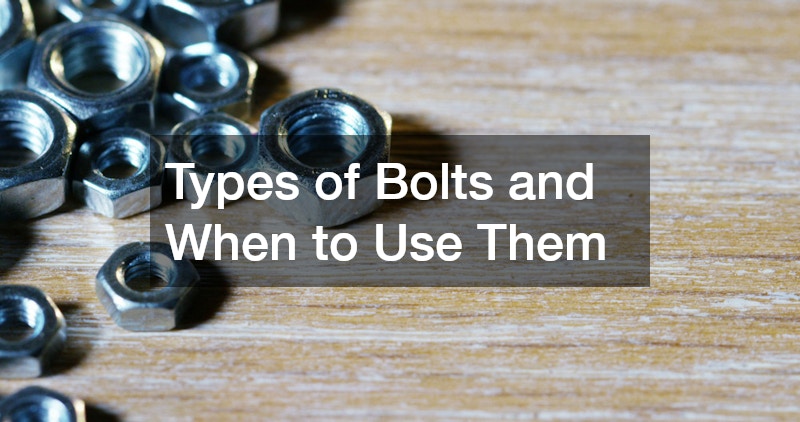
Bolts are essential fasteners used in a variety of applications, from construction to automotive to household repairs. Understanding the different types of bolts and knowing when to use each can greatly enhance the durability and safety of your projects. This article explores common bolt types and their appropriate applications.
Hex Bolts
Hex bolts, characterized by their hexagonal heads, are one of the most common types of bolts used in construction and machinery. These bolts are known for their straightforward installation and high tensile strength, making them ideal for situations that require high-load capabilities. Their design ensures that they can be easily tightened or loosened with a wrench or socket set, contributing to efficient assembly processes.
In construction, hex bolts are often used to connect metal to wood or other metal structures, providing robust and reliable fixtures. The versatility of hex bolts makes them suitable for various applications, ranging from securing steel beams in skyscrapers to mounting heavy equipment in factories. Moreover, they are available in different grades and finishes, allowing for customization based on specific project needs.
Their widespread application in both commercial and residential projects underscores the importance of selecting the right hex bolt grade and finish to prevent rust and wear. When working with hex bolts, it is crucial to ensure compatibility with the materials being joined, as this will influence the overall strength and longevity of the connection. By understanding the unique advantages of hex bolts, users can utilize them effectively in both heavy-duty and routine installations.
Carriage Bolts
Carriage bolts, with their round heads and square necks, are typically used in wood construction and offer a smooth finish on one side of the assembly. This design enables carriage bolts to create a clean and visually appealing finish by preventing the bolt from turning when the nut is tightened. The square neck fits into pre-set holes, adding to its anti-rotation features, which is particularly useful in fixtures that experience movement or vibration.
They are commonly employed in scenarios where aesthetics and safety are paramount, such as in furniture construction, playground equipment, and wooden fences. Carriage bolts provide a safe and secure fastening solution by distributing load over a larger area, thereby reducing the risk of material damage under tension. Additionally, they can be used with washers to further spread the load and increase stability, ensuring a durable connection.
When selecting carriage bolts for your project, it is important to consider the environment and potential exposure to elements, as this influences the choice of material coating or finish to resist corrosion. The round head design also ensures that there are no sharp edges exposed, minimizing the risk of injury in public or residential spaces where the bolts are used. By understanding and utilizing the unique characteristics of carriage bolts, users can ensure strong and long-lasting connections.
Lag Bolts
Lag bolts, also known as lag screws, are used in heavy-duty applications where strong load-bearing capabilities are necessary, such as deck construction. Unlike other bolts that require pre-drilled holes, lag bolts have sharp threads that create their own mating threads in wood, providing an exceptional grip. They are ideal for projects involving heavy timber as the deep threading offers superior holding power compared to nails or screws.
In addition to deck building, lag bolts are widely used in securing wooden beams, posts, and other structural elements, offering a level of strength that is unmatched by conventional screws. Their robust design makes them well-suited for heavy-duty applications such as securing machinery to floors or walls. As they do not require nuts, lag bolts streamline the construction process, reducing the need for additional fastening components.
Selecting the correct size and length of a lag bolt is essential to ensure that it is capable of handling the required load without compromising structural integrity. It is important to note that over-tightening can damage the wood, so care must be taken during installation to maintain optimum pressure. Thus, understanding lag bolts and their specific uses enables builders and DIY enthusiasts to achieve secure and reliable results in demanding construction environments.
Versatility in Applications
Bolts come in various designs to accommodate different applications, providing a versatile solution for a wide range of fastening needs. From construction and automotive industries to electronics and furniture, bolts offer diverse options suited for specific requirements. Their adaptability in fulfilling various mechanical functions underpins their widespread use in countless sectors.
Manufacturers produce bolts in myriad sizes, materials, and finishes to match diverse environmental and operational contexts. This variety enables users to precisely tailor bolt usage to specific demands, whether involving dynamic load-bearing or resistance to thermal expansion. Bolts also arrantly interact with other joint components, such as washers and nuts, enhancing their utility and reach.
Bolt versatility simplifies project logistics, as a unified fastener can be adapted to tonnes of different tasks, reducing component diversity and cost. This adaptability eases supply challenges and improves project management efficiency. Through these characteristics, bolts become foundational components in engineering, crafts, and innovation.
In conclusion, bolts are a versatile and essential component in many assembly and construction projects. Understanding the different types of bolts and their specific uses helps ensure the success and safety of your endeavors. By carefully selecting the appropriate bolt for your specific needs, you can achieve optimal results and enhance the longevity of your projects.
.


